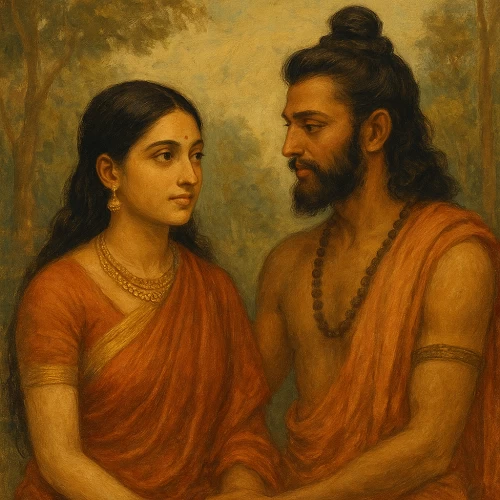Inter Varna Marriage

There are two varieties of Inter-Varna marriage:
- AnuLoma: A man marrying below his Varna
- Prati Loma: A woman marrying below her Varna
Though Inter varna marriages are usually discouraged by the texts, Anuloma was somewhat acceptable while Pratiloma was completely discouraged.
One important point to note here is that Varnas were not entirely based on birth, but by each individual's Guna and Karma. The purpose of matching by Varnas was to match people of same spiritual status with each other, for the sake of harmony.
Anuloma was most likely accepted while Pratiloma wasn't because in the ancient times the world was very physical, work was physical, woman had to seek refuge of a man and couldn't live by herself. A woman needed a man for her safety, for her livelihood. A woman marrying a man less refined than her meant physical danger and abuse. While in Anuloma marriage the man would suffer if the match was a mismatch, the man socially had more freedoms and wasn't confined to the boundaries of the house, and thus he had ways to reduce the ill affects of a bad marriage.
Here, we will study a few examples of Inter-Varna marriages from the texts
AnuLoma
Agastya and Lopāmudrā
Lopamudra was the daughter of the King of Vidarbha. Agastya was a Brahmin sage; Lopāmudrā was raised as a Kshatriya princess. Their marriage is among the first instances of Inter-varna marriages. [1]
Chyavana and Sukanyā
Sukanyā, daughter of King Sharyāti (a descendant of Manu), accidentally harmed the meditating sage Chyavana. To atone, she married him and served him loyally. Chyavana was a powerful Brahmin sage, Sukanyā a royal princess — a Kshatriya. [2]
Richeeka and Satyavati
Richeeka, a Brahmin rishi, married Satyavati, a Kshatriya princess of the Kanyakubja kingdom. Their son was Jamadagni, and grandson was Parashurama, the Brahmin-warrior. [3]
Draupadi & Arjuna
Arjuna win over Draupadi in a Swayamvara, but he came to the Swayamvara as a Brahmin, everyone considered him a Brahmin at the time, though he was a Kshatriya by birth and was in disguise at that time. Shows that people accepted the union.
PratiLoma
Yayati and Devayānī
King Yayati, a Kshatriya, married Devayani, the daugher of Brahmin guru Shukracharya. The marriage was solemnized with Shukra’s consent, showing that individual merit and circumstance could override varṇa rules in ancient times. [4]
Dushyanta & Shakuntala
King Dushyanta, a powerful and righteous ruler of the Puru dynasty, is on a hunting expedition in the forest. While pursuing a deer, he accidentally enters the sacred hermitage (ashram) of the revered Sage Kanva. Sage Kanva is away on a pilgrimage, and his foster daughter, the exquisitely beautiful Shakuntala, is tending to the ashram. Shakuntala is the daughter of the celestial nymph Menaka and the powerful sage Vishwamitra, abandoned at birth and raised by Kanva. Dushyanta is instantly captivated by her charm, grace, and innocence. They fall deeply in love. Dushyanta, feigning to be a common traveler, learns about Shakuntala's true lineage, which makes her a suitable match for a Kshatriya king. Overcome by their mutual affection, they decide to marry through a Gandharva Vivaha.
If Shakuntala is considered the daughter of Kanva, this example qualifies as a Pratiloma marriage. Her biological father sage Vishwamitra was a Kshatriya by birth, but had achieved Brahminhood by his penance. This is however a borderline example.
Sources
- Rigveda, Mahabharata, Puranas
- Mahabharata – Vana Parva
- Mahabharata – Adi Parva
- Mahabharata – Ādi Parva, Sambhava Parva, Chapters 70–81